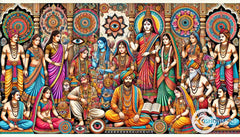Exploring the Meaning of Lingam of Shiva in Hinduism

Exploring the wonders of Hinduism often leads many to the mysterious and sacred hindu Shiva Linga. A common query arises: what truly is the real meaning of Shiva Lingam, and why does it hold such an esteemed position in Hindu spirituality? The quest for understanding real meaning of this powerful symbol brings together devotees of Lord Siva, anthropologists, and lovers of Indic art in a shared journey to reveal term linga and its deep meanings.
One fascinating aspect about Shiva Linga is its representation as both a symbol of creation and destruction within Hindu cosmology, embodying the complex dualities of existence. According to the Linga Purana, the Lingam is a complete symbolic representation of the formless Universe and the origin of the phallic form of Shiva. The union of the Shiva Lingam and the yoni symbolizes the unbreakable unity of male and female, from which all life originates, with the goddess Shakti representing the female creative energy.
This blog will guide you through the origins, symbolism, worship practices, types, and locations of Shiva Lingas. It aims to educate and illuminate the spiritual path that surrounds this emblematic icon.
Discover with us an ancient tradition alive today.
What Is the Shiva Lingam?
Moving from the introduction of Shiva linga means and Lingam’s significance in Hinduism, we now explore this symbol’s intricate details. The Shiva Linga represents an abstract representation of Lord Shiva, regarded highly across cultures for its symbolic importance in Shaivism, a major tradition within Hinduism.
This sacred icon embodies both the generative power and the cosmic energies of creation and destruction, encapsulated by Lord Shiva himself. Crafted from various materials such as precious stone, metal, clay, or wood, these lingams are central to worship in many Hindu temples dedicated to Shiva.
The historical roots of the Shiva Lingam trace back to ancient civilizations like the Indus Valley civilization around 5,000 years ago. It is mentioned in several Sanskrit texts and has evolved through ages into a complex symbol representing masculinity while also encompassing feminine principles when paired with yoni; together they depict male and female as creative forces and energies harmoniously intertwined.
The Shiva Lingam represents Shiva and is a representation of all three powers in one—Brahma, Vishnu, and Shiva. It also holds a mysterious and indescribable power to induce concentration of the mind and vibrations of peace, harmony, and oneness with the source when installed at home or temple.
Temples across India venerate this deity form with rituals that include offerings of milk and fresh flowers on cylindrical rocks and pillars with rounded tops – manifestations of divine force. In every lingam worshipped lies not just a stone or sculpture but a deep-seated belief in unity between spiritual energy (Shakti) and consciousness (Shiv), mirroring nature’s forces at play.

Origin of the Shiva Lingam
The Shiva Lingam holds a profound place in Hindu religious tradition, representing the essence of Lord Shiva. The Shiva Purana explains the origin of the phallic form of Shiva, the cosmic pillar of fire (Linga), and the right way to worship Shiva Linga as detailed in its 11th chapter. Scholars trace its origins back to ancient texts like the Puranas and Vedas, where it symbolizes divine masculinity and power.
This sacred stone is more than a religious icon; it embodies the merging of masculine and feminine energies, illustrating the balance inherent in the universe. The earliest archaeological evidence points to worship practices dating over 5,000 years ago, showcasing its longstanding significance in spiritual rituals.
Crafted from various materials including quartz and river stones from locations like the Narmada River, each Shiva Lingam is unique. The most revered among these include those found at Gudimallam, which dates back nearly 2 millennia and stands as testimony to its enduring allure across centuries.
These lingams are not just objects of veneration but serve as focal points for meditative practices - directing mind towards understanding cosmic intricacies through tangible symbols.
Every year during Maha Shivaratri festival hundreds gather around these iconic representations across numerous temples dedicated to divine observances marking unity between God’s universal presence with natural elements found on earth making history much richer by intertwining religion with spirituality.
Historical Significance in Hinduism
Transitioning from the origins of the Shiva Lingam, its deep-rooted historical significance in Hinduism unveils a rich tapestry of religious, cultural, and cosmological narratives.
Ancient texts and sculptures depict the lingam as a pivotal symbol of deities in Shaivism, one of the major traditions within Hindu philosophy that venerates Lord Shiva as the supreme deity. This veneration is vividly captured in Hindu texts like Vedas and Upanishads, where the lingam is revered not just as a phallic symbol of the god shiva but as an embodiment of Lord Siva’s cosmic power and spiritual truths.
Through millennia, this emblem has woven itself into the spiritual fabric of Hindu society, serving both as an object of worship in temples and as a focal point for meditation.
Historical records trace back to structures such God Shiva’s representations at sites dating over 5 centuries ago, showcasing short cylindrical pillars with rounded tops – quintessential forms representing divine male energy.
These artifacts stand testament to early Indian civilization’s engagement with metaphysical concepts through tangible symbols. Devotees have long performed rituals involving offerings like milk over these sanctified stones in dedicated shrine spaces or Garbhagriha (innermost sanctuary), underscoring their importance across generations.
Worship practices surrounding these ancient relics highlight how intertwined physical elements can evoke profound spiritual experiences and insights into Brahman - ultimate reality according to Vedantic teachings - illuminating paths to moksha or liberation of the soul from the cycle of birth, death, and reincarnation.
Representation in Temples
Temples dedicated to the Hindu god Shiva often house stunning representations of the Shiva Lingam, symbolizing Lord Shiva’s omnipotence. Crafted from stone or metal, these lingams serve as focal points for worship and ritual in Śaivism, attracting devotees from around the globe.
The yoni, representing the goddess figure Shakti, who is also known as Shiva's consort, is often depicted alongside the lingam. This symbolizes the union of the male gods and female principles in Hindu tradition.
The architecture surrounding these lingams is richly adorned with carvings that tell ancient stories from texts like the Śvetāśvatara Upaniṣad and symbolize deep spiritual concepts such as creation, destruction, and regeneration.
In many temples, particularly in South India and along the banks of the Narmada River in Ōṅkār Māndhātā, mūrtis of Shiva Lingam are venerated with offerings of milk, water, leaves, and flowers by priests and lay worshippers alike.
These rituals underscore the Lingam’s significance as a conduit for divine energy (Śakti), connecting believers to Para Brahman—the ultimate reality beyond form. Each gesture within this practice is deeply symbolic; pouring milk over the lingam represents purification and sustenance while offering flowers signifies devotion and surrender to God’s will.
What Does the Shiva Lingam Symbolize?
The Shiva Lingam embodies a convergence of masculine and feminine energies, represented through the lingam and yoni, illustrating the unity and interconnectedness of male and female principles.
This symbol reflects the totality of existence, capturing both the creative power and destructiveness of Lord Shiva. It signifies not just fertility but also the supreme being the cosmic egg from which cosmic egg and all creation emerges, thereby linking it to cosmology’s understanding of the universe’s origin.
The Shiva Lingam serves as a potent reminder that divinity encompasses both genders, acting as a visual representation of this deep philosophical concept deeply rooted in Hindu beliefs. The Shiva Lingam is more than just a symbol; it is an emblem of balance, creation, and destruction within the cosmos. More Shiva Lingam properties include its transformative and protective qualities, making it sacred to the Hindu religion.
In temples dedicated to Shiva across India and beyond, worshipers often focus their devotions on this sacred object. Through rituals involving water, milk baths or offerings made directly to the lingam itself—is considered one way for devotees to engage with these profound energies directly.
Art lovers will appreciate how its smooth cylindrical design merges seamlessly with its base—the Yoni—symbolizing unity between Earth (the divine feminine) and sky (the divine masculine).
This physical representation offers insight into ancient wisdom about harmony between different forces within nature.
Symbolic Meaning of the Lingam
Lingam, a Sanskrit word that seamlessly blends the abstract with the tangible, serves as a profound and only the outward symbol, of Shiva within Hinduism. This iconic representation marries the masculine forces with the feminine energies, symbolizing not just fertility but also the totality of all existence.
It reaches beyond a mere phallus; it is an emblem of creation itself, echoing Lord Shiva's dynamic and creative power. Scholars and devotees see it as a marker of cosmic energy where male aspect (Shiva) and female aspect (Parvati) merge into one entity.
In traditional beliefs stemming from texts like Vedanta and Tantra, lingam is often encased in yoni, which together represent nature's duality: balance and unity between opposing forces.
This depiction goes to lengths to embody concepts such as birth and destruction - core tenets in the cyclical process of life according to Hindu philosophy. Each Shiva lingam found across various temples or natural settings symbolizes this perpetual cycle, making it more than just stone; they are venerated artifacts believed to harness divine male and female energies.
Lingams crafted from materials like cryptocrystalline quartz or those sourced from sacred rivers like Narmada hold special significance due to their origin stories linked directly back to ancient scriptures and practices celebrating Lord Shiva’s essence - encapsulating both physical manifestation along with spiritual depth.
The Lingam and Yoni: Male and Female Energies, and Goddess Shakti
The Lingam and Yoni symbolize the union of male and female energies, highlighting a fundamental aspect of Hindu cosmology. This representation embodies masculine and feminine principles that are essential to life’s creation and sustainment.
The Lingam, often associated with Shiva, symbolizes the generative power of the universe while the Yoni, representing the female energy, stands as the source of all existence. Together, they illustrate how life emerges from harmonious balance.
Temples across India enshrine this sacred unity through Murtis that depict both Shiva's phallus (Lingam) and its base (Yoni), offering devotees a visual meditation on fertility and creation’s duality.
These symbols guide spirituality enthusiasts about Ātman's journey in Hinduism to understand Brahma Sutras' profound teachings. By recognizing these interconnected energies within themselves, individuals can foster a deeper connection to universal forces at play in their lives.

The Lingam’s Role in Cosmology
Hindu cosmology assigns a central role to the Shiva Lingam, viewing it as a symbol that captures the entirety of the universe's creation, preservation, and destruction aspects. Ancient texts like the Vedas and Upanishads highlight its significance in replicating cosmic processes on a microcosmic scale.
This embodiment extends beyond mere representation; it serves as an axis mundi connecting physical existence with celestial realms. Through rituals and reverence towards the Shiva Lingam, devotees engage in a practice that encapsulates fundamental principles of Samkhya philosophy, emphasizing duality’s transcendence through unity.
Worship of this sacred symbol integrates metaphysical concepts with tangible acts, illustrating how material offerings can bridge human consciousness with divine energies. Such practices underscore not just philosophical richness but also offer insights into Hinduism’s intricate relationship between science and spirituality.
Their significance reinforces beliefs around Ātman (the soul) and Brahman (universal consciousness), advocating for harmony between earthly existence and cosmic order.
How Is the Shiva Lingam Worshiped?
Devotees show reverence to the Shiva Lingam through a series of rituals and practices that embody deep spiritual significance. In temples dedicated to Shiva, worshippers pour offerings such as milk, honey, and water over the lingam, symbolizing purification and devotion.
This act is known as Abhishekam and expresses respect towards Lord Shiva’s formless aspect, encapsulated within the lingam. Lighting lamps and burning incense accompany prayers recited in Sanskrit; these elements combined create an atmosphere of devotion and veneration.
Offerings of flowers, Bilva leaves—a plant dear to Lord Shiva—and sweet foods are also common, each element carrying its symbolic meaning related to Shaivism teachings. Devotees engage in circumambulation around the lingam or perform Sankalpa—taking a vow before it for self-purification purposes.
Special festivals see an increase in these activities, especially during Maha Shivaratri when night-long vigils honor Shiva's cosmic dance that brings creation, preservation, and destruction into balance.
Through these methods of worship—ranging from personal devotion at home with shiva lingams made from sand or Narmada river stones to grand ceremonies in caves or ancient temples—followers seek a connection with the divine essence of Lord Shiva embodied within this sacred symbol.
Rituals and Practices in Shiva Worship
Worship of Shiva involves a series of deeply symbolic rituals that reflect reverence and devotion to this major deity in Hinduism. These practices, rich in tradition and meaning, offer insights into the spiritual and cultural dimensions of Shiva worship.
1. Devotees honor the Shiva Lingam, a representation of Shiva, with water, milk, and honey during a ritual known as Abhishekam. This act symbolizes purification and the sustenance of life.
2. Believers often present Bilva leaves to the Lingam. The trifoliate shape of these leaves represents the three aspects of Shiva: A destroyer, creator, and preserver.
3. The chanting of mantras accompanies many rituals. Among these chants, "Om Namah Shivaya" is considered exceptionally powerful for invoking Shiva's energy.
4. Worshipers observe Maha Shivaratri annually, dedicating an entire night to Shiva worship through fasting, singing bhajans (devotional songs), and meditating to seek His divine blessings.
5. Powders such as Vibhuti (sacred ash) are applied on the forehead as a reminder of life's transient nature, echoing teachings from texts like Ātman (Hinduism) on understanding the impermanent self (ego).
6. Followers frequently visit temples dedicated to Shiva to pay homage directly at the Mukhalinga - an iconographic representation combining features of Vishnu and Brahma with those of Shiva.
7. The practice of circumambulating the lingam or temple (Pradakshina) signifies respect for all creation as aspects of Shiva's existence.
8. Participants engage in annadanam—offering food to fellow devotees at temples; this embodies selflessness and recognition of Shivatattva (essence of Shiva) in everyone.
9. A unique aspect involves acknowledging the union between male energies (Shivatattva) and female energies (Shakti), seen clearly in rites surrounding both the Lingam and Yoni representing cosmic dualities.
10. The reading or recitation from sacred texts like Śvetāśvatara Upanishad enriches understanding about Ātman ("soul" or "self") correlating with Lord Shiva's universal presence.
11. Historically significant ceremonies incorporate elements from Agama Shastra principles that emphasize temple construction aligned with cosmic laws demonstrating eternal connection between macrocosm and microcosm through architectural symbolism.
These practices encapsulate more than acts of devotion; they embody philosophical insights into existence's nature grounded in millennia-old traditions that continue guiding followers to spiritual enlightenment.

Offerings Made to the Lingam
Shifting from the intricate rituals and practices dedicated to Shiva worship, many devotees express their reverence through various offerings made to the lingam. These offerings carry deep symbolic meanings, resonating with themes of fertility, creation, and the cyclical nature of life.
Devotees commonly offer water, milk, honey, and clarified butter (ghee), symbolizing purification and sustenance for both the physical and spiritual worlds. Such offerings align with the belief that Lord Shiva's presence in the lingam absorbs these essences, sanctifying them.
The offering of Bilva leaves is significant; its trifoliate shape represents Shiva’s threefold nature as creator, preserver, and destroyer.
Fruits, flowers especially Bilva leaves which are dearly beloved by Shiva due to their medicinal properties which resonate well with health restoration attributes associated with Deity himself.
The act mirrors a cosmic exchange where human aspirations meet divine energy enshrined within the Shivling's venerable form. Sandalwood paste adorned upon it serves dual purposes - cooling the fiery aspect attributed to Lingam while marking respect towards its sacredness.
Finally, lighting lamps (diyas) around promotes illumination of one’s inner self as much as it honors this ‘fiery’ emblem grounding celestial energies on earth thereby continuing an age-old tradition linking humanity directly with cosmological essence housed within Lingams across temples or natural reserves ritually carved or naturally formed emphasizing aniconism prevalent within Hindu practice encapsulating reverence towards divinity transcending mere idol worship into profound spiritual engagement observed throughout generations imbued within cultural ethos threading back over millennia reflective indeed of civilization’s enduring quest for understanding numerous manifestations embodying divine principle underlying universe itself embodied succinctly yet profoundly via simple yet poignant gestures speaking volumes about depth ingrained within such perennial acts of devotional fervor manifesting tangibly across time space bringing forth connection unseen yet palpably felt among those partaking in said ritualistic observances aimed at invoking godhead residing therein every Shivling worshipped henceforth today symbolizing continuity amidst change meriting reflection among anthropology spirituality indio art lovers alike drawing closer insights pertaining complex nuances characterizing Hinduism rich tapestry interwoven threads metaphysical philosophic doctrinal dimensions explored further providing ample fodder thought contemplation engaging intellect heart simultaneously nurturing growth holistic manner fostering deeper appreciation understanding indian cultural heritage passed down across ages undiminished vitality relevance contemporary society grappling myriad challenges facing mankind urging return simpler values espoused ancients pointing way.
Common Methods of Devotion by Devotees
Devotees engage in a variety of practices to show their devotion to the Shiva Lingam. Each method reflects a deep respect for its spiritual significance and embodies the vibrant traditions of Hinduism.
1. Daily rituals involve bathing the Shiva Lingam with water, milk, honey, or ghee, symbolizing purification and nourishment. This act signifies cleansing oneself of sin and impurities.
2. Offering flowers, especially white jasmine, to the Shiva Lingam represents purity and innocence. Devotees lay these offerings at its base as a mark of respect and adoration.
3. Lighting lamps with ghee around the Shiva Lingam during prayer sessions dispels darkness and ignorance, guiding devotees to enlightenment.
4. Chanting the mantra "Om Namah Shivaya" in front of the Shiva Lingam helps worshippers connect deeply with Lord Shiva's energy. This practice instills peace and meditative focus.
5. Fasting on Mondays is another common method of devotion, showing self-discipline and sacrifice in honor of Lord Shiva.
6. Circumambulating or walking around the Shiva Lingam clockwise reflects the cyclical nature of life and universe, acknowledging Lord Shiva as the eternal center.
7. Placing Bilva leaves on the lingam has great religious merit; these leaves are said to cool Lord Shiva’s fiery lingam, soothing his temper after defeating demons.
8. Participation in Maha Shivratri, a night dedicated to Lord Shiva, involves keeping vigil through the night with prayers and meditations focusing on Lord Shiva's formless aspect.
Transitioning from rituals focused on individual worship practices provides insight into how communities collectively venerate this sacred symbol during festivals and ceremonies across different cultures within Hinduism.
What Are the Different Types of Shiva Lingams?
Shiva Lingams are distinctive spiritual symbols with several variations, each holding profound significance in Hinduism. The Narmada River Lingam, revered for its origins from one of India's sacred rivers, embodies natural divine energy and is often worshiped for its healing properties.
Gudimallam Lingam stands out as the oldest known Shiva Lingam, dating back 14 million years and symbolizing the amalgamation of Shiva’s power with primitive anthropomorphic form.
This ancient phallus of Shiva merges religious reverence with historical mystique, attracting both devotees and scholars intrigued by its enigmatic past.
In addition to these, there exist numerous Shiva Lingam stones utilized for varied purposes - from worship to enhancing personal spirituality. Each stone or representation serves as a potent emblem of Lord Shiva's generative power and cosmic existence.
Crafted from different materials or emerging naturally in caves or riverbeds, these lingams invite followers into a deeper contemplation of divinity and creation’s intricate web.
As we explore further the venues where these sacred objects find their sanctified space reveals yet another dimension of this venerable tradition.

Narmada River Lingam
Narmada River Lingams, also known as Banalinga, hold a special place in the hearts of devotees and art lovers alike. These naturally occurring lingams are found in the sacred Narmada River in Onkar, India.
According to traditional beliefs, each stone or linga represents the power of Lord Shiva and each stone is considered to have divine energy. Unlike other lingams that artisans craft from man-made materials, these stones are shaped by natural forces over millions of years, making their presence even more awe-inspiring.
Collectors and spiritual practitioners cherish them for both their aesthetic beauty and their profound symbolic significance.
The process through which Narmada River Lingams obtain their smooth, iconic shape involves centuries of erosion by river water. This aspect underscores the geological marvels of nature while illustrating how spirituality and earth sciences can intertwine beautifully to present artifacts that resonate with both anthropologists studying ancient civilizations' worship practices and modern-day followers seeking tangible connections with the divine.
Their uniqueness lies not just in appearance or origin but also in being potent symbols embodying Lord Shiva’s generative powers—making them an integral part of rituals aimed at harnessing masculine urge to create.
Transitioning into discussions about another significant artifact - the Gudimallam Lingam offers a glimpse into history's oldest known representation of such cosmic energy.
Gudimallam Lingam: The Oldest Known Lingam
Moving from the naturally sourced Narmada River Lingam, we turn our focus to the Gudimallam Lingam, celebrated as the oldest known lingam. This ancient artifact resides in a small shrine within the Parashurameshvara temple, near Tirupati in Andhra Pradesh, India.
Experts date it back to as early as the 2nd or 3rd century BCE, marking it as a pivotal icon in Shaivism and a significant piece of religious art history. This stone is distinct for embodying an anthropomorphic form of Shiva emerging from its base - a rarity among representations of Shiva Lingams.
The Gudimallam Lingam breaks from traditional depictions by combining both abstract and figurative aspects of Shiva. Here, Lord Shiva is depicted standing tall on the apasmara purusha demon symbolizing ignorance; he holds a simple axe and deer on either side.
The simplicity and symbolic richness of this lingam draw worshipers and scholars alike. Its endurance through centuries underscores the timeless relevance and reverence that these symbols hold within Hindu tradition.
The Gudimallam Lingam stands as an enduring testament to Lord Shiva's integral presence across millennia.
Shiva Lingam Stones and Their Uses
Shiva Lingam stones, revered symbols of deities in Hinduism, carry profound spiritual significance. Crafted from the sands of time, these stones embody the essence of Lord Shiva's power and fertility.
Each stone serves as a potent symbol and emblem of creation and destruction, encapsulating the cosmic dance of life itself. Devotees use these stones for worship and meditation, channeling Lord Shiva's energy to attain spiritual elevation.
The Narmada River Lingam, formed over 14 million years ago, stands out among them for its unique natural origins and is considered especially sacred.
Artisans sculpt Shiva Lingams with great reverence from materials like sandstone or crypto-crystalline quartz. These lingams are not just static objects but dynamic participants in daily rituals that connect believers to their deity in temples dedicated to Shiva across India.
As manifestations of both male (lingam) and female (yoni) energies, they illustrate the union necessary for life's continuation—the heart of many offerings made to the lingam during worship practices reflects this principle deeply rooted in balance and harmony.
Following our exploration into the varied types of Shiva Lingams will be an insightful journey into where these sacred stones can be found globally—highlighting their presence beyond temple confines into nature’s embrace.
Where Can Shiva Lingams Be Found?
Temples dedicated to Shiva, renowned for their spiritual significance in Hinduism, house the revered Shiva Lingams. These temples serve as pivotal sites where devotees gather to perform rituals and practices in adoration of Lord Shiva.
Among these sacred spaces, the Gudimallam Lingam stands out as the oldest known representation, embodying centuries of devotion and worship.
Prominent Shiva Lingams also grace landscapes beyond temple confines, found naturally along riverbanks or nestled within caves. The Narmada River is particularly celebrated for its naturally occurring Lingams, revered by followers as Swayambhu or self-manifested embodiments of Shiva.
Such sites attract enthusiasts from various fields including anthropology and spirituality, drawn to explore the profound fusion of nature’s artistry with divine symbolism.
Temples Dedicated to Shiva
Shiva temples stand as a testament to the profound spirituality and rich architectural heritage of Hinduism, drawing anthropology enthusiasts and spiritual seekers alike. Renowned for their intricate carvings and sacred spaces, these temples serve as places of worship and repositories of ancient art and culture.
The symbolism embedded within each structure reflects deep philosophical concepts such as creation, preservation, and destruction encapsulated by Shiva's cosmic dance.
One prominent example is the Gudimallam Lingam found in one such temple, which dates back to 2nd or 3rd century BCE, making it one of the oldest known lingams in existence. This particular site provides a unique insight into early Shaivism practices and the symbolic representation of Lord Shiva as both creator and destroyer.
Art lovers marvel at its craftsmanship while scholars explore its significance in understanding the evolution of lingam worship across centuries.
Prominent Shiva Lingams Around the World
Across the globe, Shiva Lingams serve as a symbol of Lord Shiva's generative power, embodying the profound intersection of spirituality and art cherished by anthropology, spirituality, and Indios art enthusiasts.
In India, the Gudimallam Lingam stands out for its age and as a representation of how ancient cultures sought to encapsulate divine energy in material forms. This oldest known lingam merges myth with history, tracing back over 2 millennia, showcasing early Hindu artistic expression and religious sentiment.
Exploring beyond India's borders reveals Shiva Lingams situated in natural settings and temples worldwide, marking the global footprint of Shaivism. These sacred stones resonate with the original meaning attributed to them in scriptures like Agama (Hinduism) and texts such as "Shvetashvatara Upanishad," serving both as objects of veneration and focal points for meditative practices.
Whether nestled in caves or presented on temple grounds, these lingams continue to draw seekers from across continents eager to experience a connection with Lord Shiva’s transcendent essence.
Shiva Lingams in Nature
Shiva Lingams in nature represent the raw and powerful essence of Lord Shiva's creation, often discovered in caves or resting on the ground, echoing the symbolic link between the divine and the earthly.
These naturally occurring icons are revered as direct manifestations of Shiva's presence within the world, embodying both sanctity and cosmic energy. Found across India’s diverse landscapes, from dense forests to remote mountainous regions, these lingams offer a unique spiritual experience that connects devout followers with nature’s profound mysteries.
Spiritual seekers and devotees view these natural formations as extraordinary signs of Shiva’s endless generative powers. The belief in their ability to harness cosmic energy makes them sought-after for personal worship and meditation practices.
Unlike lingams crafted by human hands, those formed by nature itself carry an intrinsic value tied to their origin story—thought to have come directly from Shiva, meaning "auspicious." Their formation through geological occurrences over millennia instills a sense of awe towards life's perpetual cycle guided by divine forces.






















